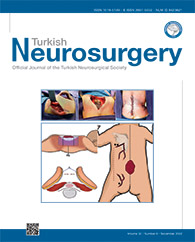2Georgetown University Medical Center, Department of Neurology, Washington, DC, USA
3Georgetown University and MedStar Washington Hospital Center, Department of Neurosurgery, Washington, DC, USA DOI : 10.5137/1019-5149.JTN.38377-22.3 Patients with aneurysmal subarachnoid hemorrhage (SAH) continue to have poor functional outcome due to the occurrence of delayed cerebral ischemia (DCI). Although vasospasm represents the primary therapeutic target for mitigating DCI, DCI occurs through multifocal etiologies that involve impaired cerebral autoregulation. Worse pressure reactivity index (PRx) values, which consists of a moving correlation coefficient between intracranial pressures and mean arterial pressures, have been shown to be associated with DCI in non-randomized clinical trials.
Here, we discuss two patients that presented with high-grade SAH and comatose exams. Patient one was a 34-year-old male diagnosed with SAH from a ruptured right middle cerebral artery aneurysm. He had intact PRx values (Mean: -0.07 during hospital days 9-19), while having severe, refractory vasospasm. At the conclusion of his hospitalization, he was functionally independent, had negligible DCI, and was successfully discharged home. Patient two was a 78-year-old female diagnosed with SAH from a ruptured anterior communicating artery aneurysm. She had an improving PRx ranging from -0.1 to 0.1 early in her hospitalization. However, upon developing severe vasospasm, her PRx increased to 0.6 (overall PRx from hospital days 4-16 was 0.3), and she suffered from extensive DCI in bilateral middle cerebral and anterior cerebral artery distributions that ultimately resulted in malignant cerebral edema and brain death.
In conclusion, cerebral autoregulation as measured by PRx may represent a viable target for neuroprognostication by evaluating DCI risk in patients with SAH who develop severe or refractory vasospasm. Further studies evaluating the role of cerebral autoregulation, PRx, and its pathophysiological role in DCI are warranted.
Keywords : Subarachnoid hemorrhage, Delayed cerebral ischemia, Vasospasm, Pressure reactivity index, PRx, Autoregulation, Aneurysm




